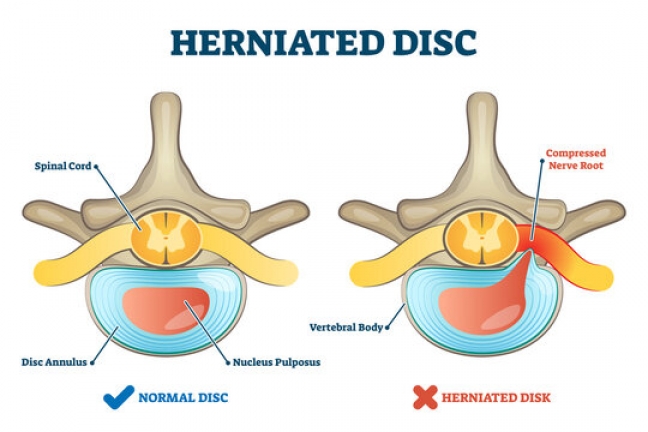Protect Your Spine: What You Need to Know About Herniated Discs
Herniated discs have become increasingly common in today’s population. Sciatica symptoms, such as lower back and leg pain, have been found to arise from herniated discs. Treatment for Herniated discs may include chiropractic care and physiotherapy.
It is generally essential to receive optimal treatment in order to relieve symptoms and experience pain relief. Recent research has found that exercises such as standing lumbar extensions and stretches such as the Cobra Pose can be beneficial in targeting radiating pain and in reducing the amount of pressure on the discs in your back.
What is Herniated Discs?

A herniated disc (sometimes referred to as a “slipped disc”) is when the soft center of a spinal disc is forced out through a tear in the outer layer. This can result in increased pressure on your nerves, leading to sciatica, or radiating pain. Herniated discs can occur for various reasons, including poor posture and wear-and-tear, so it’s important to be mindful of your posture and seek medical advice if you experience pain in your spine in order to avoid any long-term damage done to your spine.
Sciatica Symptoms and Imaging
The symptoms experienced by a person with sciatica can vary largely depending on the severity of the herniated disc. Examples of sciatica symptoms traditionally include pain which radiates along the sciatic nerve (from the lower back and extending down the legs). It can also result in a numbness and tingling sensation. Other potential issues caused by herniated discs include difficulty walking and maintaining balance. Diagnosis of herniated discs typically involves imaging, such as an X-Ray, MRI, or CT scan, which can help rule out other conditions and better pinpoint the herniation site.
Exercises to Strengthen the Core
Exercises that strengthen the core and support the spine can be beneficial in reducing the pain associated with a Herniated Disc. These exercises focus on building stability in the core, which beyond preventing herniations from occurring in the first place, can also aid in management of a diagnosed condition. Examples of such exercises include planks, bridges, pelvic tilts, and opposite arm/leg extensions.

Yoga and Pilates
Yoga and Pilates are great for overall body health and strength, and can help with herniated discs and sciatica symptoms. Both forms of exercise involve stretching and strengthening the muscles, so they’re excellent for supporting the spine and improving posture. Focus on poses such as cobra, cat/cow, and child’s pose.
Therapy and Professional care
Massage therapy, acupuncture, and chiropractic care can help to reduce pain and speed up the healing process. Each of these approaches offers unique benefits, so it’s best to speak with a professional to determine which therapy is most appropriate for your situation.
Cold and Hot Compress
Applying cold or hot compresses to the affected area can also assist in pain management. Cold compresses can be used to reduce inflammation and reduce the size of a herniated disc, while hot compresses generally provide relief from radiating pain. It’s important to be mindful of which type of compress you need – advice from a chiropractor is recommended. Please be cautious of the temperature of compress used, as either can cause skin burns if not used correctly.
Lifestyle Changes
Certain lifestyle changes can also be beneficial for those suffering from herniated discs. Avoiding activities which involve heavy lifting or repetitive motion can help to alleviate the strain on the spine. Getting enough sleep, eating a healthy diet, and drinking plenty of water helps to keep the body healthy and well-balanced, making it easier to manage herniations and reduce the risk of further injury.
Medical Attention
If sciatica pain persists for more than six weeks, or if the condition worsens, it’s important to seek medical attention. A chiropractor can diagnose the condition and prepare an effective treatment plan. It’s important to have the herniated disc checked frequently, even after pain reduction. This will allow your chiropractor to monitor progress and watch for signs of deterioration or further injury. Keeping records of treatment and progress can also be helpful in the event that symptoms do return or worsen.
Maintaining good communication with a healthcare provider is key in helping to manage herniated discs and protect long-term health.In some cases, surgery may be required to fix the herniated disc, but this is rare and should only be considered after all other options have been exhausted.


